
Stu Eddins
March 18, 2024

The user clicks your ad and hits your landing page. Within the first 10 seconds, they assess the headline, any images, and maybe the first sentence or two of content. Then, one of two things happens:
Content is the key to a landing page’s success. After clicking on an ad or email hyperlink, a user will only give the landing page a few seconds to prove their click was worthwhile. For perspective, the statement and its two bullets shown in red above take most people about 10 seconds to read. That’s not a lot of time, but for 50% or more of your marketing traffic, that’s all the time you’ll get to capture their attention.
The 11th second is earned—or lost—by how relevant the headline and initial paragraph are to the visitor’s search query or intent. Look in Analytics; how are your current landing pages doing when it comes to earning more than 10 seconds of attention from your ad visitors?
This article is part of a series on marketing landing pages. In this installment, we will focus on how landing page content must be relevant to both the campaign and the visitor.
A “bounce” is defined in Analytics as a visit lasting 10 seconds or less with no event interactions. On average, 60% of non-branded paid traffic spends less than 10 seconds on the landing page and then bounces off.
There is no secret to what it takes to make visitors engage with a landing page instead of bounce. To retain visitor attention and avoid the dreaded bounce, the landing page content must be relevant to the visitor’s needs and aligned with their purpose and intentions.
We discussed that landing pages are the new keywords in a related article. Part of that blog summary:
Complicating that last part about click cost:
Given these factors, marketers need to refine their processes to maintain, let alone enhance, current performance. The landing page is the marketing asset with the greatest influence and impact on relevance.
Earning attention in marketing isn’t easy, so when a campaign does connect with a prospect, it’s no small feat. In search marketing, out of six ads and 10 blue links, they chose you. Yet for most marketers, the win is very brief. 50-60% of campaign visitors arrive on the landing page, look around for 10 seconds or less, and leave. The landing page couldn’t earn the 11th second.
Poor landing page relevance is costly in two ways. First, through increased cost per click which also means increased cost lead. Next, poor relevance squanders the opportunity created by the campaign, costing a potential lead because the page didn’t fulfill the promise of the marketing message.
The most common reason for a bounce is that marketers promote one thing, but the landing page appears to have content about something else. Campaign targeting and messaging are often a mismatch to the content on the landing page.
We frequently see mismatches where ad copy for a specific program or service leads to a page written with generic content.
The solution to this mismatch is to create more specific landing pages. Ads that target welding classes should lead to landing pages about welding classes. Ads for accounting classes should lead to pages about accounting classes.
We get it. Creating and managing a host of marketing landing pages aligned with each unique marketing theme can seem daunting, time-consuming, and expensive. But the payoff can be better click-through rates, lower cost per click, and better-qualified leads with greater application to registration yield.
We’d call that “winning.”
Setting up unique and specific landing pages can present some challenges, such as maintaining consistent brand identity, aesthetics, and voice. Then there are the mechanics of setting up forms or click-to-call phone numbers and adding conversion tracking for each page. Thankfully, there are ways to smooth out the process and help ensure every marketing page starts from the same footing.
One recommendation is to build a marketing landing page template. Create and use one template across all marketing landing pages. Using a template creates natural compliance with fonts, phone numbers, colors, and forms. When using a template, Analytics tracking can be built-in so that basic data is always collected. Please note that this templated approach can be on your website or hosted through a service such as Unbounce.
But your biggest concern is likely creating new content for all those new pages. While that can be a challenge, there are ways to create a winning content formula that reduces the creative writing workload.
Let’s assume that your current landing pages are indeed converting some visitors. Rather than tossing all that content out, mine the pages for their useful parts.
Start with your current landing pages and analyze them for similar content about your institution. This is the body content you need to have on each page to support your brand. Collect all the institutional content and rewrite it as one or two paragraphs or sentences.
Do the same with the college- or category-level content. Collect all the content about the business school, the health sciences college, or the continuing education program and combine it into distinct paragraphs for each category-level theme.
You now have enough body content to populate two-thirds of any landing page. Next, all you need is a paragraph or two relevant to the specific program, service, or brand message being promoted. Once you have this last section, invert the order of your previous landing pages:

There’s more to a landing page than these three blocks of body content—call-to-action, testimonials, other callouts, motivating headlines, and sub-headlines—but for most of the clients that I’ve worked with, creating body copy looks like the insurmountable obstacle in front of them.
Here’s the good news: since it’s a best practice to block marketing landing pages from organic search, you can save time by reusing content as needed. A person who hits the accounting landing page probably will never see the nursing landing page, so it won’t be noticed that you reused the institutional body copy. You need to test landing page content and layout to learn what serves your prospective students best. What works well for the two-year bookkeeping program may not perform as well for a doctoral program.
Benchmark landing page performance before making any changes and take another reading just before any future edits or updates. Look at the bounce rate in GA4, calculate the user conversion rate, note the lag time between the first click and the converting click. In Google Ads, note the cost per click and click-through rate to determine if the page update has improved ad rank and relevance. Pay attention to the number of conversions (should increase) and the cost per conversion (should decrease). These last two metrics are the two most important for any campaign.
You have 10 seconds or less to keep a marketing visitor on your landing page. How will you earn the 11th second?
We earn the 11th, 12th, and even the 20th second the same way: through engaging, useful, and highly relevant content. By aligning our landing pages with campaign targeting and ad copy we increase engagement with our marketing message and reduce our cost per lead earning better-qualified leads.
While your current landing pages are generating conversions, it’s very likely they could be much more efficient. Study your pages and collect all the institutional/brand content into one or two paragraphs, then do the same at the college or category level. Finally, write new content for the specific program/service/brand message being promoted and make that the page’s lead content.
Measure, always, so that you can learn how your changes affected page performance and prove the value of your methods.